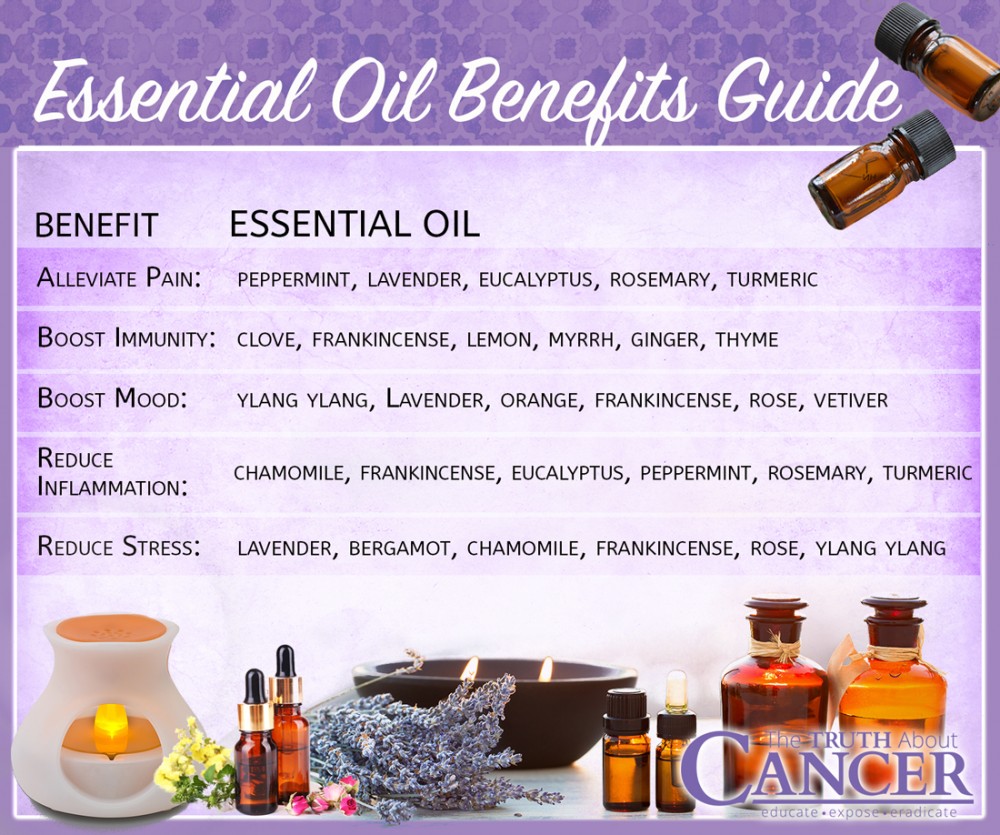By Ty Bollinger
Since before the time of record keeping, essential oils have been used to support the body, mind, and spirit. Many ancient civilizations, including the Egyptians, Romans, Greeks and Chinese highly prized essential oils, and valued them as sources of healing to include in their traditions of medicine.
These days the many beneficial properties of essential oils are best realized when utilized as an adjunct or supplement to other treatments for inflammation, and those that help heal from or prevent disease. Use essential oils in combination with a diet of healthy, real, natural foods that are chemical-, pesticide-, antibiotic-, and hormone-free.
The Dangers of Inflammation
One of the ways your body responds to stress is by creating inflammation, regardless to whether this is stress from your environment, lifestyle, or diet. The result will be an inflamed or heated area.
For example, catching a cold you are likely to incur a fever, which is a type of inflammation that your body uses to eradicate an invading virus. Of course, this is a beneficial and acute kind of inflammation. However, there is a modern-day epidemic that is destroying the balance of your body – chronic, low-grade inflammation.
You become more susceptible to disease and aging when your body is confronted with constant inflammatory response. Slowly, but surely, environmental and dietary toxins build up in your body, activating your immune system, keeping it on high alert, and hyper-reactive, all in a state of inflammation. Stress, chronic food allergies or sensitivities, and leaky gut are also sources of inflammation.
Healing Touch & Essential Oils
Many essential oils have anti-inflammatory properties: frankincense, myrrh, peppermint, lavender, turmeric, and clove oils, just to name a few. Combining these oils gives you extra power to fight the dreaded inflammation that is so prevalent in bodies at risk of, or dealing with cancer.
A wonderful way to get the powerful benefits of these or any essential oil is through the healing touch of massage. Using touch in healing is a practice derived from techniques and customs that are as rooted in human history as essential oils. Originally massage was a sacred system of natural healing. Over extensive periods in history, cultural shifts have perverted this ancient art so it’s viewed as merely an indulgence, rather than the beneficial supplement to healing that it is.
Luckily, today, there has been a resurgence in the understanding of this form of holistic therapy. Nowadays it’s well-accepted that massage has the ability to reduce pain, improve lymphatic flow, enhance immune function, increase alertness, and ease depression, among other benefits.
As you probably know, there are many different types of massage. Modern therapists practice various techniques that come from traditions that span back across time and geography. The goal remains the same – assist others to experience a higher quality of life, and improve their emotional and physical well-being.
Research dedicated to proving the benefits of massage therapy continue to grow. All of these benefits can aid in healing from cancer, as well as to help stop it from gaining a foothold in the first place.
Studies show that massage can:
•Help fight depression – In 2010 researchers reviewed the effects massage therapy has on symptoms of depression by carrying out a meta-analysis of 17 studies with a combined 786 participants. Each of the studies demonstrated the positive effects of touch massage on depression, when compared to those in the control groups.
•Reduce stress – Sports Medicine published a review stating the positive effects of touch massage on muscle soreness and recovering after injury or physical exertion.
•Offer pain relief – In 2014, meta-analyses revealed that massage therapy reduced pain, anxiety, and depression in 404 patients with fibromyalgia who received at least five weeks of massage therapy.
•Promote hormone balance – Studies indicate massage can decrease adrenocorticotropin hormone, nitric oxide, and beta-endorphin levels while increasing levels of oxytocin.
•Lessen inflammation – In 2012, a study examined the results of touch massage on young males with damage to their muscles. It was observed that massage mitigated cellular stress, and decreased the expression of cellular stress.
Essential Oils + Massage = Greater Healing
Using essential oils in combination with massage can enhance the benefits, greatly. The proven benefits of massage coupled with the myriad of therapeutic components of essential oils create a powerful combination of restorative therapy, for a wide variety of conditions and health challenges.
While there is an abundance of massage therapists, not all use essential oils in their practice. Ensure you ask before booking a massage session. Do also ensure the oils they use are 100% pure and certified organic.
The Best Essential Oils for Cancer Healing
We’ve written extensively on The Truth About Cancer about the healing benefits of a wide range of essential oils. Here is a brief recap of my top five favorite cancer-fighting oils:
Frankincense
Frankincense is anti-inflammatory, and helps boost immune function. It improves circulation, reduces stress, and is a recognized pain reliever. It has demonstrated the ability to speed regeneration by contracting and toning tissues. In addition, essential oil of frankincense provides neurological support.
Beyond cancer treatment this essential oil has other benefits, including: encouraging skin health, aiding digestion, easing arthritis pain, and balancing hormones.
Lavender
Lavender is excellent for its ability to calm the nervous system and ease stress and anxiety. It also helps improve the quality and depth of sleep.
Lavender has long been used for pain relief, and in recent years has been studied extensively for its inhibitory effects on cancer tumor growth. Other uses for lavender essential oil include its ability to heals burn and skin irritations, relieve allergy symptoms, and as an anti-bacterial, antiseptic, and antifungal.
Myrrh
In cancer support, myrrh essential oil contains anti-inflammatory properties and in research studies is indicated in the inhibition of cancer cell growth. It is reported to support healthy hormone balance, be an effective pain reliever, and is also anti-fungal.
Peppermint
Peppermint essential oil has antioxidant properties and is a potent anti-inflammatory. Peppermint also stimulates cell regeneration, promotes new tissue growth and liquefies mucous, making it ideal for respiratory issues. It is also one of the best essential oils for aching muscles.
If suffering from nausea, try inhaling or diffusing peppermint essential oil. Peppermint is also one of the best oils for stomach upset by helping to reduce gas and improve digestion.
Turmeric (Curcumin)
Turmeric oil is very promising in cancer treatment regimes. This is due to components observed to inhibit enzymes that can lead to inflammation, suppress tumors, kill fuel and oxygen sources for cancer cells, stop cancer stem cells from returning, and preventing metastasis.
Turmeric essential oil has been shown to promote apoptosis (cancer cell death), yet has the ability to differentiate between normal and cancerous cells. Turmeric is a renowned anti-inflammatory, with thousands of research studies to date demonstrating its myriad of benefits.
Outside of cancer healing benefits, turmeric essential oil can also offer assistance in: helping wounds to heal, preventing Alzheimer’s, regulating blood sugar, weight loss, and relief from arthritis.
Note of caution: While using essential oils can enhance your life and health in a variety of ways, they are not cure-alls. Those dealing with a serious disease should use these therapeutic supplements as part of a supervised treatment plan.



